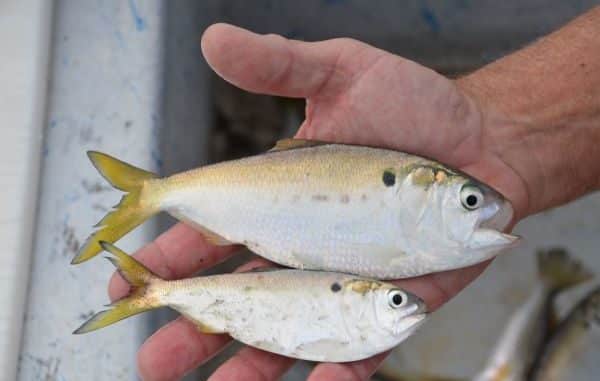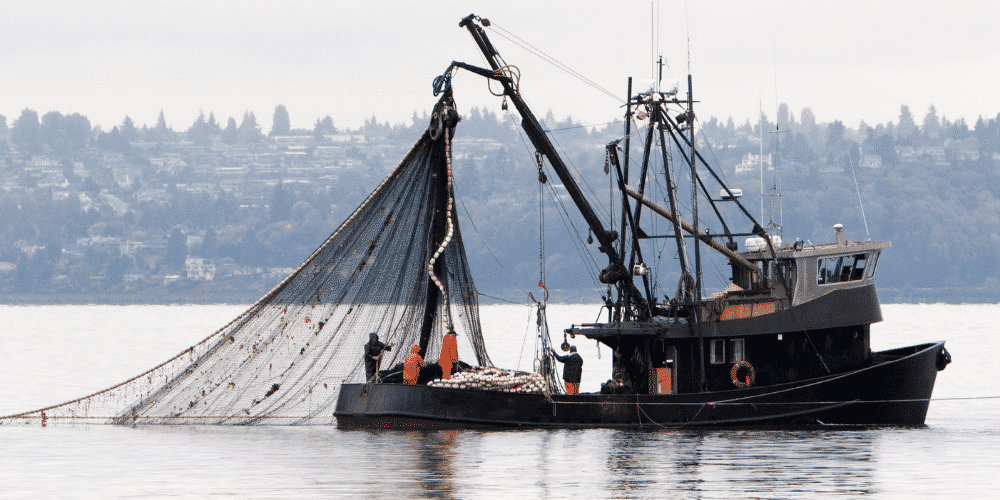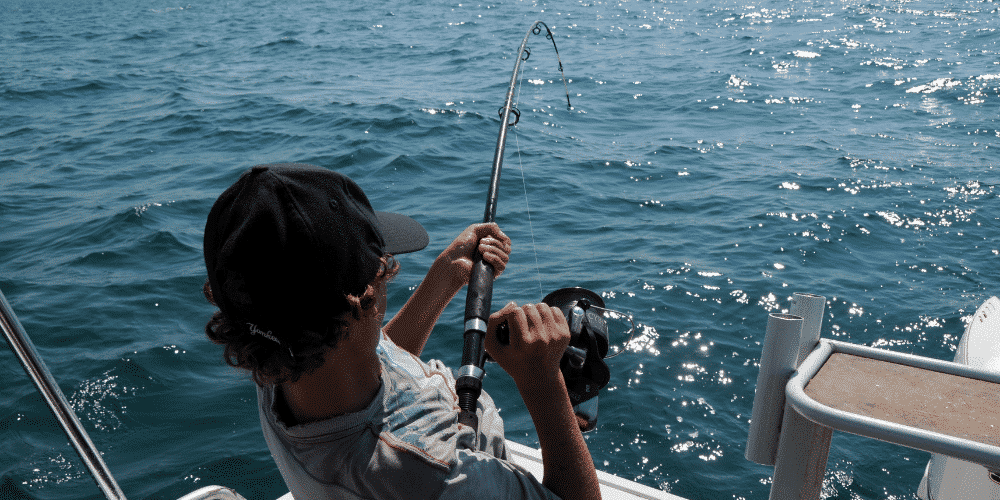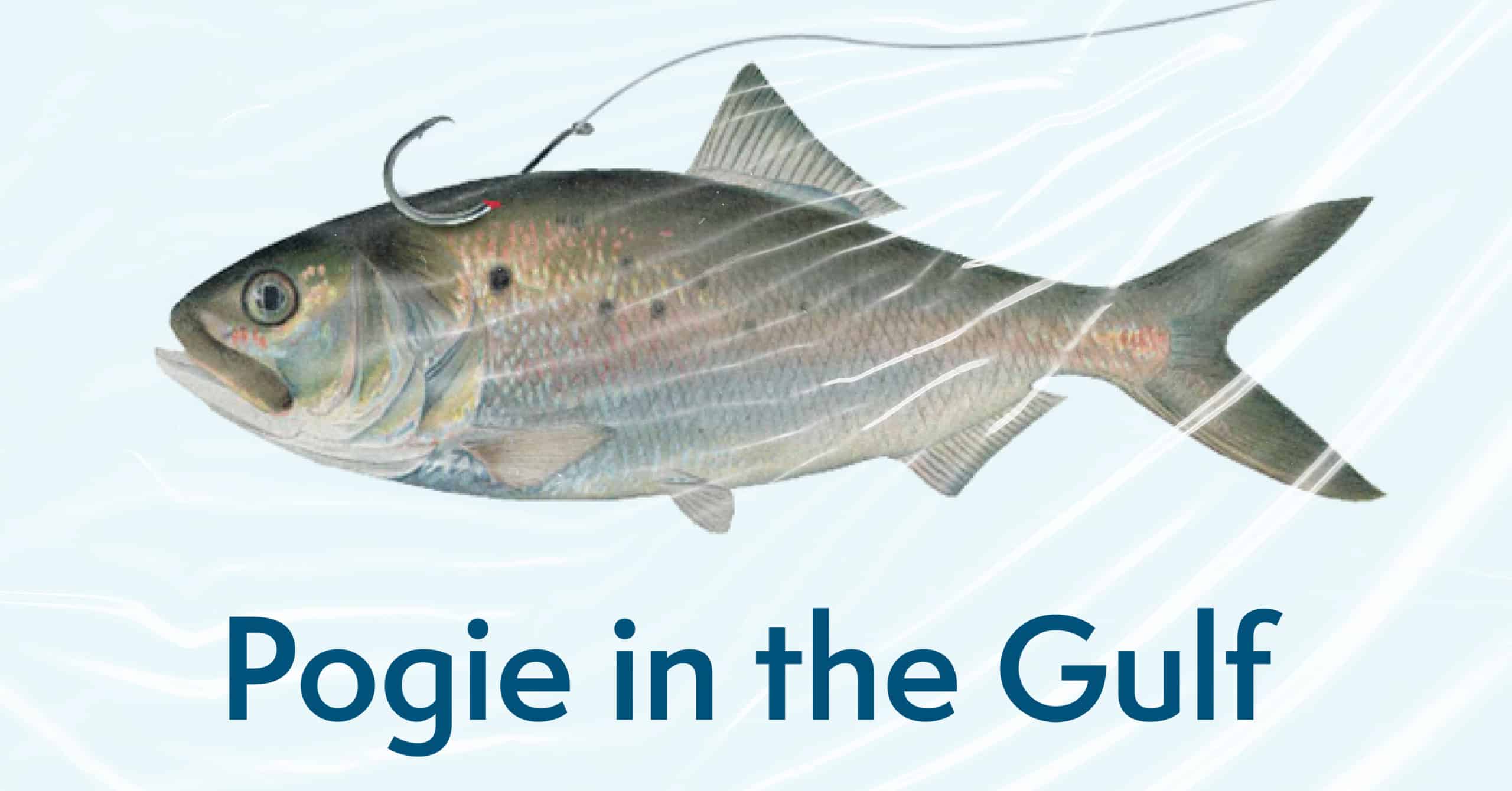It is during the colder months that pogie fish, also known as Gulf Menhaden, spawn and feed offshore in the Gulf of Mexico. These fish are the most abundant bait fish around.
Pogies numbers are awe-inspiring, numbering in the millions. They swim in massive, silvery schools that attract many predator species.
“The abundance of pogie bait in the Louisiana Gulf is unbelievable in January, February, March and April,” said Captain Troy Wetzel, Louisiana Offshore Fishing Charters. But what are pogie fish?
What is a pogie fish?

Pogie is more of a slang word used to refer to Menhaden. Belonging to the Herring family, Menhaden are sometimes referred to as the most important fish in the world. This is due to their large numbers, the fact that they are eaten by so many other fish, and their several other uses.
The name pogie or pogy may have originated from the north-eastern American French name for menhaden (fish) or poghaden.
Menhaden are flat, silver-colored fish with soft flesh. They also have a long, forked tail. These pogie fish are small (around 8 inches) and can grow to 15 inches (38cm) in length and vary in weight.
Both Gulf menhaden and Atlantic menhaden have small, oily-fleshed fish. They are bright silver with a series of smaller spots behind their main, Humeral spot. They are more slender than Yellowfin menhaden and Finescale menhaden. The tail rays of Yellowfin menhaden are brighter than those of Atlantic menhaden.
A pogie’s diet
Pogie are able to travel in large, slow-moving schools with open mouths. These pogie fish are known as filter feeders. This means that they filter water through modifications to the branchial apparatus (gill arches and gill-rakers).
Pogie typically have two main sources for food: phytoplankton and Zooplankton. The diet of a pogie varies greatly over its life span and is directly proportional to its size. Menhaden under one year old eat primarily phytoplankton. As they grow, adult menhaden gradually shift to eating primarily zooplankton.
Predators of the pogie
Menhaden are preyed upon by many predatory fish. These include striped bass, weakfish, and bluefish, as well as by birds such as ospreys and eagles. Humpback whales off the coast of New Jersey also feed on pogies. Other cetaceans, such as fin whales and dolphins eat pogies quite frequently. Dolphins can eat up to 20 pounds of menhaden a day.
Historical uses of pogie fish
Menhaden were used historically as fertilizers for crops. Menhaden was likely the fish Squanto instructed the Pilgrims how to bury fresh-planted seeds alongside them as fertilizer. Pogie can also be used as bait for fishing, feed for livestock, and “menhaden oil” for human consumption and manufacturing.
In the early years, thousands of fishing ships were harvesting pogie. There were many facilities along the Atlantic coast that could quickly turn the fish into something of value, usually oil. Later fish meal became more popular. Later, The Tragedy in the Commons began and the menhaden population started to decline. Many of these small businesses could not be managed, leaving only a few menhaden fishing firms to survive on the Atlantic coast.
Many sources claim that menhaden is not edible, but the fish used to be eaten as sardines might be or fried. For breakfast, Maine fishermen would eat fried pogies. Fish that weren’t sold as bait would be sold to the less fortunate for food.

The Menhaden fishery
The menhaden fishery is the largest by weight in the Gulf, averaging 1.1 billion pounds per year. Almost all of that catch is reduced into fish oil, meal, and solubles.
Many studies have been done on bycatch in the fishery, showing it ranges from 0.06 to 3.9 percent by number and 1 to 2.8 percent by weight.
How the fishery is monitored
Menhaden catches are closely monitored. The menhaden companies provide catch records and the captain’s daily fishing reports directly to the National Marine Fisheries Service. Port agents with NMFS also regularly take dock-side samples of pogie fish catches.
Size and age data from these samples are used, along with catch records, to assess the health of the pogie stock.
How are pogies processed
At the dock, menhaden catches are unloaded from carrier vessels using pumps that move the fish directly into a steam cooker.
The fish are moved to a press that squeezes oil and water from the fish, leaving what is known as “press cake.” This press cake is dried, and ground into meal and treated for storage.
The oil and water is pumped through screens and filtered to remove particles that are added back to the press cake before it is dried.
Oil is separated from the water and purified for storage or shipment.
How are the pogie fish used
Menhaden fish meal – this fish meal has a minimum of 60 percent protein and a well-balanced amino acid profile. Feeds for aqua cultured fish may contain up to 20 percent fish meal. It is also used in feeds for baby swine. Large quantities are used in all-natural dog food.
China is the largest consumer of fish meal from the United States. Because of these exports, the fishery provides jobs in the US funded with dollars imported from other countries.
Menhaden oil – Although some of the fish oil produced is used in Idaho rainbow trout farms, most is exported to Europe and Canada for use as aqua cultured salmon feed.
Most of the rest that is used domestically goes into pharmaceutical and over-the-counter fish oil capsules. Although the use of menhaden oil in human foods, such as margarine and cooking oils was approved in the U.S. in 1997, no Gulf of Mexico menhaden oil presently goes to making these products.
Fishing for pogie bait fish
As day breaks, Capt. Troy and his crew head offshore a short distance from Venice, La. to where these “pogie balls” are popping up out of the water. According to Capt. Troy, the monster-sized Wahoo weighing up to 120 lbs. can be caught about 20 to 80 ft. around the oil rigs where they gather ready to ambush the pogie bait fish.
“Big Yellowfin tuna weighing up to 250 lbs. also migrate here during this time of year to have a feeding frenzy on these pogie balls,” said Capt. Troy.

Using pogie as bait fish
Up and down the Atlantic coast and throughout the Gulf of Mexico, schools of these popular baitfish hug the shoreline and the beaches.
Officially known as menhaden, these schools measure in acreage terms rather than numbers. Huge schools can be seen flipping their tails at the surface, moving along with the tidal currents. They are usually fairly close to the shore, sometimes right behind the breaking surf, but can be found as far as a mile or more offshore.
There is security in numbers, and security is what these fish need. They are a favorite food for many saltwater species up and down the coast. Redfish, cobia, king mackerel, tarpon, and sharks are some of the major predators that will follow these bait pods.
Catch your own pogies
Pogies are not usually purchased from bait shops because they do not survive well in captivity. People fishing with pogies catch their own, using cast nets in the pods of baitfish on the beach behind the breakers. Often one good cast of the net will catch more pogies than the average boat needs.
Fishing with your newly-caught bait
Fishing with pogies as bait fish can be done in a variety of ways. In the spring, following the bait pods will be cobia and large redfish. Fishing for them involves either anchoring and fishing live pogies both freelined and on the bottom in the area of the bait pods, or site fishing and tossing a live pogy bait to a waiting marauder.
Oversized redfish (larger than twenty-seven inches in length) are common; some very large cobia will be caught as well. The ever-present sharks provide some thrills to anglers fishing with this method, some of them ten feet in length!
Best time to fish with pogies in the Gulf
If you’re looking to catch monster-sized type of fish in the Gulf of Mexico, January, February, March and April are considered to be the best times of the year. And pogies are considered to be the best choice of Louisiana bait fish.
Visit our website to learn more about booking with Louisiana Offshore Fishing Charters or call 504.701.3474 for more information.




